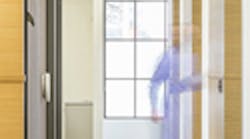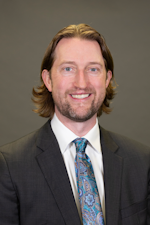Horacek Dental and Fieldwork Design reimagine what's possible in “dental” architecture
Editor's note: Click on images to enlarge
This is the story of Horacek Dental, a general dental practice in Portland, Oregon. It is the story of a forgotten building, a passionate architect, and a dentist dissatisfied with the norm.
* * *
“I took a few pictures of “traditional” dental offices
with drop ceiling, granite, etc. –
offices that look nice, but don’t have any character.
I sent those to [the architect] and said ‘Don’t do this.’”
– Dr. Horacek
Horacek Dental, owned and operated by Richard Horacek, DDS, first opened its doors in 2006. After operating in a more-or-less “traditional” space for eight years, Horacek Dental moved into an unlikely spot for a dental practice: A woodworking mill.
A tour of the new office might go something like this:
First, you walk inside and take a good look around. Then you become confused – you’re not quite sure you’re in a dental office. Just to make sure, you walk back outside to double check the address. The address is, in fact, correct, so you walk back in and move toward the reception area.
Looking up, you see the building’s original, 14’-high, trussed ceiling. Once painted white, it’s been walnut-blasted, revealing the natural browns and golds of the old-growth fir beams. They lend a majestic, yet serene, affect to the space. Looking down, you see the building’s concrete floors. They’re original, too, though they’ve been cleaned, smoothed, and polished. Still, they have the robust character of an industrial space, bearing patches of grease where leaky machines stood their ground for decades.
Moving on, you walk into the heart of the building – three hygiene rooms and four treatment rooms. Along the way you find repurposed wood, abandoned belt sander drums (now pendant lamps), and a curious lack of overhead lights. Still, the space is bright: natural light floods deep into the rooms from two expansive skylights. The mill’s garage doors, now transformed, cradle a series of enormous windows.
In the back of the building is Dr. Horacek’s office. His cycling shoes are there, along with a bag holding a change of clothes. You assume he biked there, which he did, and notice a shower in the office. It’s essential for a dentist who pulls quick turnarounds from Lycra to surgical scrubs.
Outside Horacek Dental runs a public cycling path. You notice the property has both indoor and outdoor parking for bikes. It's easy to see that cycling is appreciated here, as it is in many parts of Portland. It’s part of an ethos that believes eco-friendliness and healthy living are not just ideas to be talked about, but lived out.
Speaking of bikes, the 4,700 foot space inside Horacek Dental feels like you could bike through it. As clinics go, it’s expansive. Apart from the bathrooms, a few closets, and a mechanical room, there are no enclosed ceilings. There are no operatory lights perched over dental chairs. There is a surprising lack of storage, yet there is no clutter. The natural flow of the walls is equally clean – uninterrupted by even a single light switch.
The tour ends when suddenly you realize that, yes, you are in a dental office. It’s just a dentist office you never dreamed of…but someone else did.
* * *
“I hate to say it, but I purposely chose a contractor and architect
who had zero experience in dental.”
– Dr. Horacek
The building of Horacek Dental was not easy. There were persistent, small pressures, like trying to stay on-time and on-budget. There were also last minute scares, like the bank calling Dr. Horacek to say it was pulling the financial plug … right before construction began. The money would eventually come, but it took a two-hour meeting and extra financial commitments by Dr. Horacek. The bank was skittish because the project had been commissioned to an unfamiliar architect – one that didn’t build dental offices – and that kind of risk was not going to go by unnoticed.
“I did have numerous other ‘dental’ architects look at the space along with ‘dental’ contractors and interior designers,” Dr. Horacek says. “I didn’t like anything they wanted to do, such as drop ceilings, overhead lights, stucco on the exterior, Marmoleum flooring, etc. … I also never wanted a ‘strip mall’ dental office or a brand new, ‘cookie cutter’ dental building.”
Instead of going strip mall and cookie cutter, Dr. Horacek went scratch awl and and dovetail joint. The idea to move into a woodshop, however, didn’t originally come from Dr. Horacek. It arose after after an agent showed him a number of properties for sale, but without success. “Nothing looked desirable to me at all,” he says.
It was only while driving through the neighborhoods near his former office that inspiration hit … on Mrs. Horacek. While Mrs. Horacek and her husband were out one day, she pointed out the woodshop, commented on the uniqueness of the building, and encouraged her husband to contact the owners. Dr. Horacek agreed. He began making inquires. It turned out the business was willing to sell, and the price was right. After a field visit, Dr. Horacek was convinced he could make it his own.
Dr. Horacek’s nine staff members, however, had a different opinion. “I couldn’t convince any of the staff it was going to be awesome,” he says. It turns out the staff members weren't the only one with reservations. Horacek’s dental supply company had concerns, too. Certain aspects of his plan, such as the decision to forego overhead lighting, were met with skepticism. During the renovation there would be other skeptics, including the enforcers of the city code and the aforementioned bank.
Without an ally, Dr. Horacek’s project would have sunk – along with his personal finances. “I had to put all of my cash reserve and working capital on the line to get [the bank] to fund it,” he says. “It was a stressful time….”
But after going through uninspired designs and fruitless meetings with multiple firms and architects, Dr. Horacek finally found the partner he needed.
* * *
of the floor and wall space.
Most of it was obscured by wood stockpiles,
tools, and machinery.”
– Cornell Anderson
In February of 2013, Dr. Horacek contacted Fieldwork Design and Architecture, a local studio and fabrication workshop founded in 2010 by Tonia Hein, Cornell Anderson, and Timothy Fouch. Dr. Horacek told the Fieldwork team about the project. They were intrigued. A site visit was arranged. After a few minutes with at the mill, Dr. Horacek knew he’d found a match. “They were excited as I was about this thing turning out really cool and different.”
Cornell Anderson, lead designer on the project, remembers the first site visit this way: “Dr. Horacek had the space prior to us enlisting us as an architect. It was … rough. Very rough. The woodshop was still a tenant, busily working away. We could only see a small percentage of the floor and wall space. Most of it was obscured by wood stockpiles, tools, and machinery.”
Anderson continues, “Dr. Horacek immediately and clearly stated he didn’t want a ‘typical’ office. He felt that he’d be there a long time, this was his practice, and so he therefore wanted something that expressed the values and personality of both he and his core patients. Prior to meeting with us, he’d commissioned other designers to study the space, and felt that they were delivering fairly boilerplate designs, and that wasn’t what he was looking for. It was clear he wanted a departure from the norm.”
* * *
“If one thing isn’t done correctly
(and I feel this way about dentistry)
from the ground up, including something
you may think is minor or insignificant,
you can feel that in the final product.”
– Dr. Horacek
Being excited and having a vision is one thing, but execution is another. In the building of Horacek Dental, Fieldwork and Dr. Horacek undertook not only an architectural challenge, but a collaborative one. Horacek was on a timeline and had to work to keep things on budget. There were major obstacles to overcome, such as the implementation of seismic upgrades. Several tricky permitting tangles arose related to jurisdictional and legal issues that were very specific to the site. Fieldwork had to place “consistent, heavy pressure” on officials to keep the process moving. The project turned into a bumpy ride at times. Dr. Horacek admits, “I didn’t think I was going to be able to have a building like this, and many a night did I worry if it was going to come true and really work.”
Over the course of the project, Dr. Horacek and Fieldwork forged a vision for the final product that would carry them through the sticky points of the process. Dr. Horacek repeatedly credits Fieldwork for transforming his ideas into blueprints. “It was always in my head what I wanted, but it didn’t really take shape until Cornell and Fieldwork got involved in shaping,” he says. “They did a great job of figuring out what I wanted without me really having specifics.”
“It was very collaborative; we felt that he was a partner,” Anderson says. “He dealt with us in a very straightforward manner, and we shared the same goals. Every project is a bit of a roller coaster ride, unknowns are part of life, but the relationship with Dr. Horacek was, and remains, solid.”
* * *
“Our sources for inspiration
were varied and diverse:
We were inspired by the character
and history of the building,
we were inspired by some of the processes
within the dental industry in general,
and Dr. Horacek in particular.”
– Cornell Anderson
Fieldwork took Horacek’s input and went to work. Anderson and his team labored to create a space that was serene, quiet, and congenial. They fought against anything that would impart a “stuffiness” to the clinic, instead reaching for a sense of warmth and ease. Particular efforts were made “to honor the professional practice,” but still make the finished product “people-focused and relaxed in stance.”
“We’ve all been in that waiting room that only serves to make the wait feel longer, and exam rooms that feel alienating,” Anderson says. “We made an effort to get the tone right. People are the focus. Dr. Horacek never pressured us to do otherwise. On the contrary, he supported that effort wholly.”
Fieldwork chose to use locally sourced materials, a decision Anderson calls “self-evident.” This intuitive way of thinking about the process is a hallmark of Fieldwork’s designs. Look through their portfolio, and you can see their past projects strike the perfect balance between the needs of the project and design potentialities.
Anderson speaks further about environmentally-conscious choices, creating an organic extension of the neighborhood, and honoring the history of the building. “Storm-water is filtered and managed on-site,” he notes. “Wherever possible, materials and finishes specified were re-purposed, have recycled content, and were sourced locally.”
Anderson adds, “Portland is a community that values its history and resourcefulness. By adaptively reusing, upgrading, and enhancing an existing building, we feel that the project reflects these values.”
To describe Fieldwork’s vision as “organic” is figurative, but to a greater degree than you might think. Fieldwork’s vision was based on integrative design principles, as well as human anatomy. In their own words, the designers of Fieldwork present the concept thusly:
“The design concept, based on the anatomy of a tooth, consists of two primary zones. The central core of the project, or ‘nerve’, is clad in a dark felt material that has a calming acoustic and aesthetic function. It contains the laboratories, administrative, and consultation spaces. The outer edge of the building, or ‘enamel’, is white with Oregon White Oak accents, and is reserved for patient service. This zone includes the staff lounge, waiting area, and the examination and operatory rooms. These spaces are focused on large windows for views and natural daylighting.”
You could simply say that Horacek Dental is a building shaped like a tooth. But then again, you’d be missing the point entirely.
* * * *
Piece by piece, the project came together. Carpenters reused part of a large beam to create a backdrop for the reception area. Other parts of the beam were used for furniture in the office. Fittingly, doors were purchased from the woodshop that sold Dr. Horacek the building. Despite early reservations, Dr. Horacek’s dental supply company helped “enormously” with the dental aspect of the setup. Fieldwork carefully considered the office’s high tech equipment (cone beam scanner, CEREC, etc.), and incorporated it subtly with the rest of the design. The original ceiling, covered with dirt and chipping paint, was walnut blasted for an “unreal” transformation.
The final aspects of the construction were completed near deadline. Finishing touches were added, such as a painted chalkboard and amenities in the waiting area. Horacek’s wife added her “awesome eye” for interior design, and she and her husband worked late hours to hang photos, select fixtures, and install FLOR carpet.
With the design and build done, the new Horacek Dental was ready for patients.
* * *
“I sat there the first week of work
talking to patients,
almost not recognizing them
because I was seeing them
in a different light.”
– Dr. Horacek
By his own admission, Dr. Horacek’s new office is in a part of town that most people “wouldn’t really look into that seriously.” But this is merely another way Horacek Dental stands as an exception to expectations. Today, patients repeatedly say they don’t feel like they are in a dentist’s office. And, to the delight of the staff (whose skepticism is long gone), patients say they don’t get the “normal dread” of going to the dentist’s office.
“The people in this area are good, down-to-earth people,” Dr. Horacek says. “Portland has a lot of good people, making it feel like a small town in that sense. They are also very healthy, active, and believe in keeping the environment clean. We have accommodated all of that here.”
He adds, “I sometimes have trouble trying to express the many ways we have adhered to this in the design and vision of the building.”
Local business owners have visited Dr. Horacek, thanking him for turning a neighborhood “eyesore” into something they can be proud of. A nearby nursery donated a large potting as a thank you. But Horacek Dental isn’t done. There are still a few outstanding items on the checklist: Fieldwork is building Horacek’s desk. The practice’s standard “dental” cabinetry, although minimal, will one day be replaced with Horacek’s wish-list installations. In the meantime, Horacek and his staff will do what they do best: routine cleanings, fillings, implants, CT guided surgeries, one-day crowns, and, of greatest importance to Dr. Horacek, services delivered in a relaxed environment at a reasonable cost.
When asked what advice he would give other dentists who are ready build, Dr. Horacek says this:
“Honestly, even though some dental industry people won’t like it, don’t listen to everything they say. Don’t get me wrong, I would have never had the building the way it is now without some help from those in the dental industry. But I really think a little less 'traditional' dental architects and contractors are the way to go to truly get what you want. I just coordinated select dental industries to talk with my contractor and Fieldwork and they all worked really well together.”
In other words, when people say, Wait! You can’t do that…
“Build what you want and find good people to help you with it. Just do what you want and make it work."
* * *
Editor's Notes: Let us know what you think. Comment below and tell us what makes a great dental office design. Have you been to Horacek Dental, or an office like it? Did you build your own office? What are the challenges of going from "a vision" to "brick & mortar"?
If you have a unique dental office that you'd like to see us feature, email Zachary Kulsrud at [email protected]



















